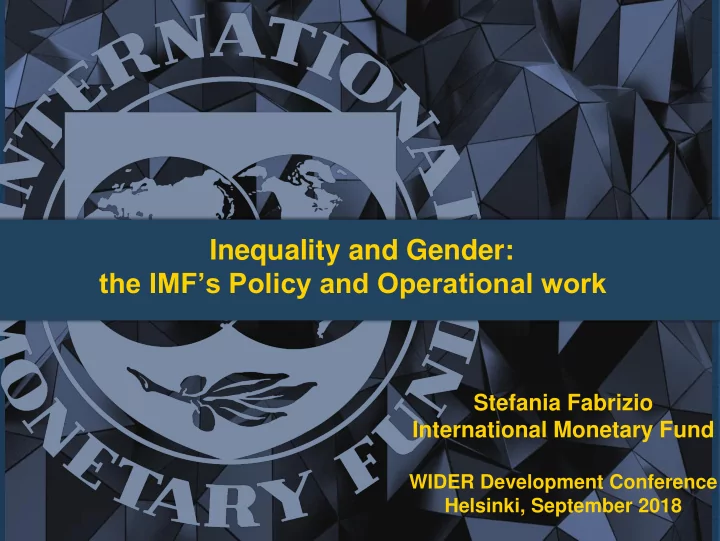

Inequality and Gender: the IMF’s Policy and Operational work Stefania Fabrizio International Monetary Fund WIDER Development Conference Helsinki, September 2018
About the presentation 1. Why the focus on inequality/gender issues 2. IMF analytical and policy work 3. IMF’s engagement with member countries 4. How the IMF approaches inequality/gender issues at country level 5. Examples 6. Going forward 2
Why does the IMF focus on Inequality? Because it is macro-critical Productivity Growth th Resource Resource Social Social and In Inequal qualit ity Productivity allocation allocation cohesion cohesion Stabili bility ty
Why does the IMF focus on gender? Because it is macro-critical Output and productivity Growth th Female ale Income Output and Economic Income Economic and Labor or For orce e inequality productivity inequality resilience resilience Partici rticipatio pation Stabili bility ty
Analytical and policy work on Inequality: some examples 5
Analytical and policy work on gender: some examples 6
IMF’s engagement with countries Pilots to Policy Advice explore how best to add value for the Capacity Development membership 7
Pilots : inequality and gender Inequality studies: completed Inequality studies: ongoing Gender studies: completed Gender studies: ongoing 8
Fr Framewo amework rk fo for r de dealing aling wit with h in inequ equality ality/gende /gender r is issues sues fr from om a m a macro acroeconomic economic pe persp rspecti ective ve 9
Focus and Topics on inequality ❑ Comparative analysis of inequality and poverty ❑ Income polarization ❑ Growth inclusiveness ❑ Expenditure composition ❑ Subsidy reform ❑ Tax progressivity ❑ Financial inclusion ❑ Rural poverty ❑ Regional income inequalities ❑ Labor market duality ❑ Assessment of reform options ❑ Impact of commodities boom-bust cycles ❑ Social protection assessment 10
Focus and topics on gender ❑ Drivers of female labor force participation ❑ Financial inclusion ❑ Public investment ❑ Labor market reforms ❑ National gender equality plans ❑ Legal barriers ❑ Diversification ❑ Corporate profits ❑ Gender-based violence and harassment ❑ Female entrepreneurship 11
India: gender equality and sanitation Gender India: Sanitation and Gender Equality Improving access to sanitation is essential for raising gender equality and economic growth. Female Labor Force Participation Increases with Sanitation Coverage Female Literacy Increases with Sanitation Coverage Kerala 60 Female labor force participation (%) Himachal Pradesh 90 50 Goa Himachal Pradesh Delhi 80 Andhra Pradesh Female literacy rate (%) Maharashtra 40 West Bengal Tamil Nadu Tamil Nadu Punjab Gujarat 70 Uttarakhand Karnataka Maharashtra Karnataka Assam Haryana 30 Rajasthan Uttarakhand Orissa Kerala Madhya Pradesh Madhya Pradesh Goa Gujarat 60 Andhra Pradesh Uttar Pradesh Jharkhand Orissa 20 West Bengal Bihar Delhi Rajasthan Jharkhand Uttar Pradesh Assam 50 10 Haryana Punjab Bihar 0 40 10 20 30 40 50 60 70 80 90 100 10 30 50 70 90 110 Sanitation coverage (%) Sanitation coverage (%) Sources: Census of India (2011), IMF staff calculations, and IMF Country Report No. 17/54 (2017 Article IV staff report for India).
Bolivia: commodity cycles and inequality Change in Inequality During Boom (2000-2005) (Gini Index, In percentage points) Change Skills Commodity Prices Fiscal Policy 0.00 0.00 -0.01 -0.01 -0.02 -0.02 -0.03 -0.03 -0.04 -0.04 -0.05 -0.05 -0.06 -0.06 -0.07 -0.07 -0.08 -0.08 -0.09 -0.09 -0.10 -0.10 Model Data 13
Distributional impact of reforms on both inequality and gender: Argentina Fema male le Labor bor Force ce Participa ticipation, tion, Policy licy Refor orms ms and d their ir imp mpacts acts 1990 1990-20 2014 14 on female le labo bor r and on GDP 80 68 70 Targetted childcare to low-income 23.3 59 60 56 56 55 and poor income families 1.8 percentage points 49 48 50 No discrimination in formal work 2.3 40 place 7.0 30 20 11.6 Reducing Tax Wedge 1.2 10 0 0 5 10 15 20 25 Change in women's hours worked in the formal sector Change in GDP 1990 2000 2014 Source: World Bank, Gender Statistics 14
IMF’s engagement with countries Training and tools available to Policy Advice both Fund staff and country Capacity Development authorities 15
Capacity Building Wo Worksho kshops ps and d Tr Training ining - Courses on inclusive growth, Te Technical hnical assi ssista stance nce financial development and -Distributional analysis is an inclusion, distributional integral part of TA on tax and analysis of policy and reforms subsidy reforms - Peer-learning workshops on - -Gender budgeting gender budgeting To Toolkits kits -Macro-distributional impact of fiscal reforms -Gender Budgeting -Distributional analysis of energy subsidy reform 16
New tool based on SDGE framework • Dynamic general equilibrium model with Framework heterogeneous agents incorporating country-specific (19 country characteristics studies) • Households (rural vs. urban) • Productive sectors (agriculture, manufacturing, services) Model features • Frictions (differential cost of mobility, segmented financial markets) • Macroeconomic variables Outcome • Inequality between and within-sectors • Poverty 17
Going forward Analytical/policy work - G-20 report on strong, sustainable, balanced and inclusive growth - Gender and technology - Role of Gender in financial stability - Gender diversity and diversification Operational work Inclusion/gender in country work when macro-critical Toolkits Expand toolkit set to consider: - Macro-distributional impact of reforms for more developed economies - Impact of reforms on gender Training - Courses on SDGE framework for modeling the macro and distributional effects of reforms 18
THANK YOU
Recommend
More recommend